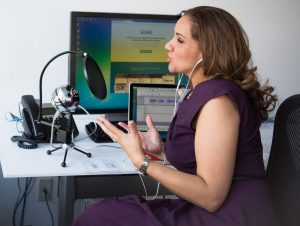Virtual meetings are becoming the new normal for job interviews, writing groups, workshops, author talks, readings, press calls and more. Finding a way to be as professional and effective on screen as you are in real life is a bit of a learning curve. Here are a few pointers…
Video Platform
There are lots of platforms to try now, many with features like screen share for free – here’s a useful overview. If you’re using someone’s else platform always do a dry run, to check you’ve downloaded the software OK, and sound and connection work. Watch out for sessions that are time-limited, as with Zoom. (Remember that poor sound will be far more frustrating for your audience than poor visuals.) If possible, have a back-up plan too – another password or login that people can use, or another platform to try.

Wardrobe
Avoid jangly earrings and bright make-up. Avoid bright colours, stripes, logos and other distracting clothes and accessories. Wear a smart-casual outfit in a darker shade, something that you feel comfortable in. Tuck the tail of your jacket under your rear to keep it looking tight-fitting and to stop it riding up as you speak. More tips on how to presentable here and here.
Posture
Prop your laptop at eye level so you’re not all chins and nostrils. Sit still, avoid moving about, and have your knees shoulder-width apart to give you a firm base. If this is all quite new, you could video yourself talking beforehand to see if anything in your tone or gestures (too many ‘ums’ or fidgety hands, for example) need addressing. We all need to learn to lose our fear of the camera!
Delivery
Avoid eating dairy beforehand – it can clog up your throat. Make ‘eye contact’ with the camera often as you speak, remember to smile, and slow your pace down – your voice may be distorted a little as it travels electronically. Speak naturally, referring to bullet points rather than reading things out word for word. A few vocal and breath warm-ups can really help. People will forgive the odd glitch or random child in the background so long as your material is inspiring or informative. (And they can hear and understand you!)
Room Setup
Go for a plain, uncluttered background that is not too distracting but has some depth – you don’t want to be right up against a wall. Bookcases can work so long as they’re not too messy or have odd covers that draw too much attention.
Light and Sound
Use your preview to check your lighting doesn’t leave your face in shadow and there’s no houseplant growing out of your head! Set up in the quietest room in your home, where you are least likely to be disturbed. Prime other people in your home to keep the noise down. You can use a simple ring light to cut out backlight, or use settings in Zoom and other platforms to optimise your appearance and backdrop. A headset – ideally in an unobtrusive style – is more reliable and clearer than speakers – far less likely to create feedback.
Content
According to InterCall, 65 percent of attendees are doing other work on a video call, so you need to work hard to keep people’s attention. Schedule shorter interactions than you might in person – for a talk, typically, 20-25 minutes followed by a Q&A. Encouraging people to comment or asking questions as you go can keep people attentive.
Screen-sharing slides and videos can enliven your talk but don’t hide behind your props – sometimes it can just as powerful simply seeing someone talk. As you gain confidence, you could include more advanced features such as votes and polls too.
BIO – Dan Brotzel is author of Hotel du Jack (Sandstone) and Kitten on a Fatberg (Unbound)
Leave a Reply